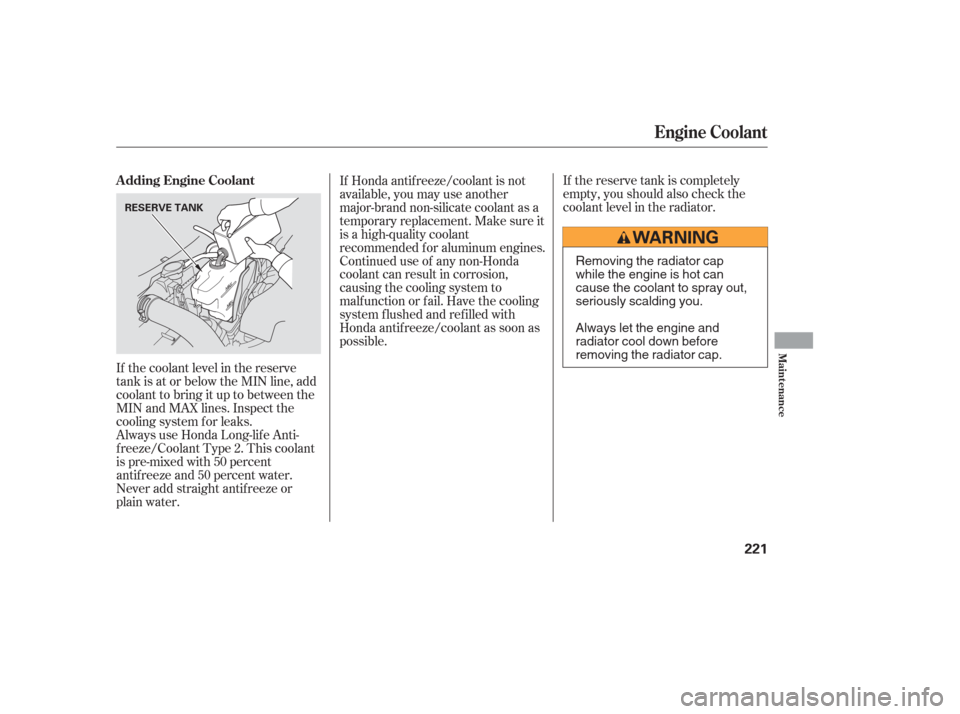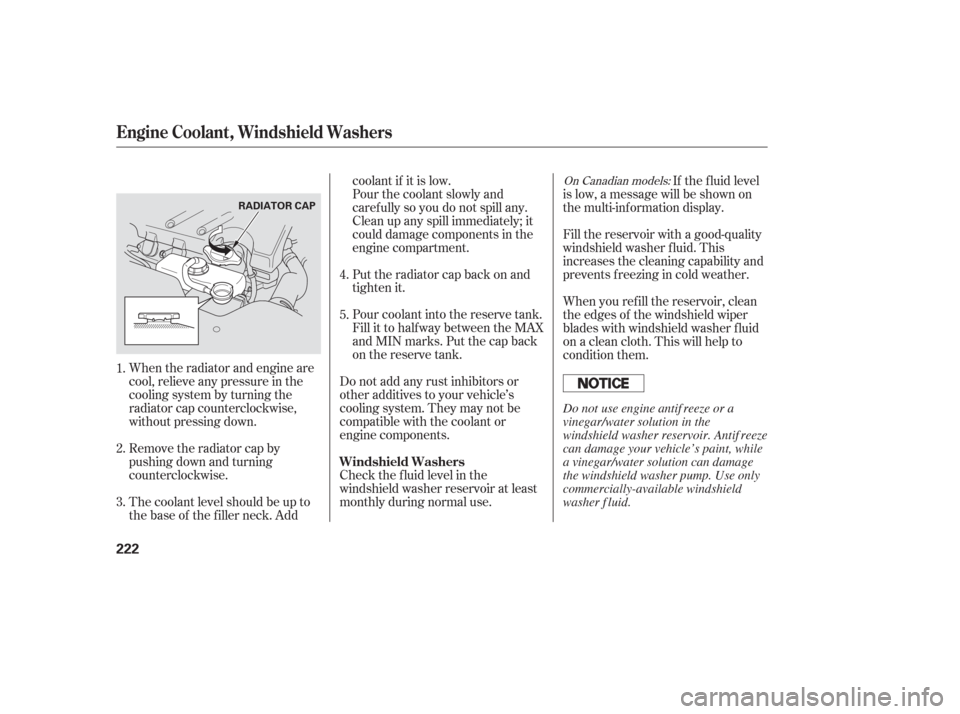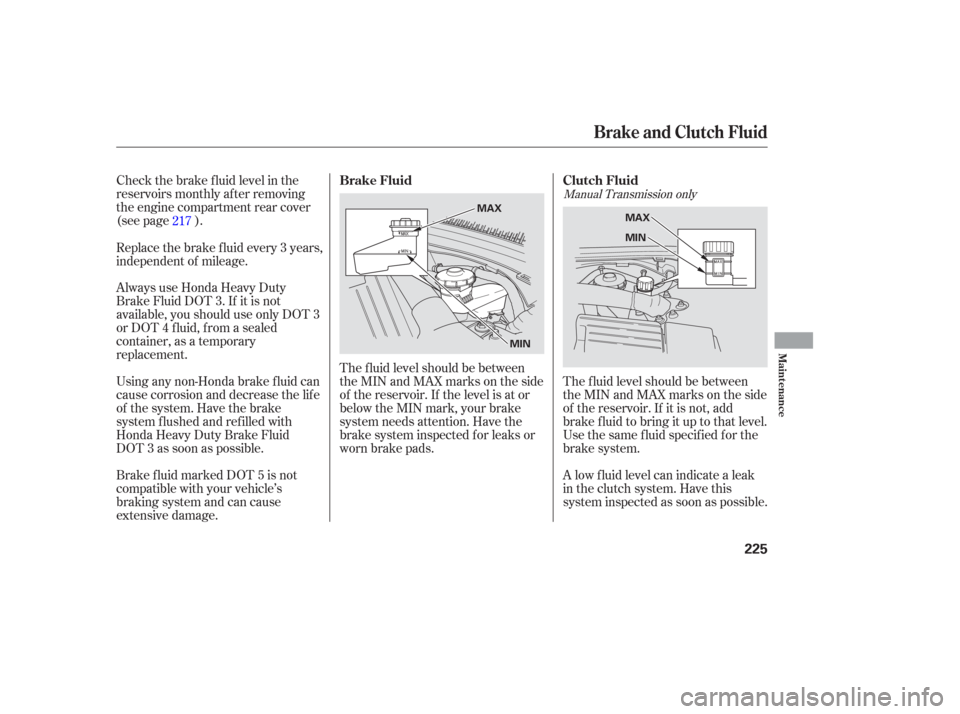Acura TL 2006 Owner's Manual
Manufacturer: ACURA, Model Year: 2006, Model line: TL, Model: Acura TL 2006Pages: 295, PDF Size: 3.89 MB
Page 221 of 295

Let the engine run f or several
minutes, then check the drain bolt
and oil f ilter f or leaks. Reinstall the engine oil f ill cap.
Start the engine. The oil pressure
indicator should go out within 5
seconds. If it does not, turn of f the
engine and check your work.
Engine oil change capacity
(including f ilter): Refill the engine with the
recommended oil. Put a new washer on the drain bolt,
then reinstall the drain bolt.
Tighten the drain bolt to: Install a new oil f ilter according to
the instructions that come with it.
Remove the oil f ilter, and let the
remaining oil drain. A special
wrench (available from your
dealer) is required. Turn of f the engine and let it sit
f or several minutes, then check
the oil level on the dipstick. If
necessary, add more oil.
Make sure the oil f ilter gasket is
not stuck to the engine block. If it
is, remove it bef ore installing a
new oil f ilter.
3. 7.
8.
9.
5.
6. 4.
Changing the Oil and Filter
220
OIL FILTER
4.5 US qt (4.3)
29 lbf·ft (39 N·m , 4.0 kgf·m)
Improper disposal of engine oil can be
harmf ul to the environment. If you
change your own oil, please dispose of
the used oil properly. Put it in a sealed
container, and take it to a recycling
center. Do not discard it in a trash bin
or dump it on the ground.
Page 222 of 295

If the coolant level in the reserve
tank is at or below the MIN line, add
coolant to bring it up to between the
MIN and MAX lines. Inspect the
cooling system f or leaks.If the reserve tank is completely
empty, you should also check the
coolant level in the radiator.
Always use Honda Long-lif e Anti-
f reeze/Coolant Type 2. This coolant
is pre-mixed with 50 percent
antif reeze and 50 percent water.
Never add straight antifreeze or
plain water. If Honda antif reeze/coolant is not
available, you may use another
major-brand non-silicate coolant as a
temporaryreplacement.Makesureit
is a high-quality coolant
recommended f or aluminum engines.
Continued use of any non-Honda
coolant can result in corrosion,
causing the cooling system to
malf unction or f ail. Have the cooling
system f lushed and ref illed with
Honda antif reeze/coolant as soon as
possible.
Engine Coolant
A dding Engine Coolant
Maint enance
221
RESERVE TANK
Removing the radiator cap
while the engine is hot can
cause the coolant to spray out,
seriously scalding you.
Always let the engine and
radiator cool down before
removing the radiator cap.
Page 223 of 295

When the radiator and engine are
cool, relieve any pressure in the
cooling system by turning the
radiator cap counterclockwise,
without pressing down.
Remove the radiator cap by
pushing down and turning
counterclockwise.
The coolant level should be up to
the base of the f iller neck. Addcoolant if it is low.
Pourthecoolantslowlyand
caref ully so you do not spill any.
Clean up any spill immediately; it
could damage components in the
engine compartment.
Put the radiator cap back on and
tighten it.
Pour coolant into the reserve tank.
Fill it to half way between the MAX
and MIN marks. Put the cap back
on the reserve tank.
Do not add any rust inhibitors or
other additives to your vehicle’s
cooling system. They may not be
compatible with the coolant or
engine components.
Check the f luid level in the
windshield washer reservoir at least
monthly during normal use. If the f luid level
is low, a message will be shown on
the multi-information display.
Fill the reservoir with a good-quality
windshield washer f luid. This
increases the cleaning capability and
prevents f reezing in cold weather.
When you ref ill the reservoir, clean
the edges of the windshield wiper
blades with windshield washer f luid
on a clean cloth. This will help to
condition them.
3. 1.
2. 4.
5.
On Canadian models:
Engine Coolant, Windshield Washers
Windshield Washers
222
RADIATOR CAP
Do not use engine antif reeze or a
vinegar/water solution in the
windshield washer reservoir. Antif reeze
can damage your vehicle’s paint, while
a vinegar/water solution can damage
the windshield washer pump. Use only
commercially-available windshield
washer f luid.
Page 224 of 295

Check the f luid level with the engine
at normal operating temperature.Park the vehicle on level ground.
Shut of f the engine.
Within 60 to 90 seconds, remove
the dipstick (yellow loop) f rom the
transmission, and wipe it with a
clean cloth.
Insert the dipstick all the way into
the transmission securely. Remove the dipstick, and check
the f luid level. It should be
between the upper and lower
marks.
If the level is below the lower
mark, add f luid into the f iller hole
to bring it to the upper mark.
The transmission should be drained
and ref illed with new f luid when this
service is shown on a maintenance
message in the multi-inf ormation
display.Always use Honda ATF-Z1
(automatic transmission f luid). If
it’s not available, you may use a
DEXRON
III automatic
transmission f luid as a temporary
replacement. However, continued
use can af f ect the shif t quality.
Have the transmission f lushed and
ref illed with Honda ATF-Z1 as
soon as it is convenient.
To thoroughly f lush the
transmission, the technician
should drain and ref ill it with
Honda ATF-Z1, then drive the
vehicle f or a short distance. Do
this three times. Then drain and
ref ill the transmission a f inal time.
Insert the dipstick all the way back
in the transmission.
1.
2.
3. 4.
5.
6.
Automatic Transmission Fluid
Maint enance
223
UPPER
MARK
LOWER
MARK
DIPSTICK
Page 225 of 295

Check the f luid level with the
transmission at normal operating
temperature and the vehicle sitting
on level ground. Remove the check
bolt, and look f or transmission f luid
coming out of the bolt hole. If a small
amount of f luid drips out of the bolt
hole, reinstall the check bolt.If no f luid comes out, remove the
f iller bolt. Slowly add Honda Manual
Transmission Fluid (MTF) until it
starts to run out of the check bolt
hole. Let the f luid run out until it
stops, then reinstall the check bolt
and the f iller bolt.
If Honda MTF is not available, you
may use an SAE 10W-30 or 10W-40
viscosity motor oil with the API
Certif ication seal that says ‘‘FOR
GASOLINE ENGINES’’ as a
temporary replacement. However,
motor oil does not contain the proper
additives, and continued use can
cause stiffer shifting. Replace as
soon as it is convenient.
The transmission should be drained
and ref illed with new f luid when this
service is shown on a maintenance
message in the multi-inf ormation
display.
Manual T ransmission Fluid
Manual Transmission Fluid
224
CHECK BOLT
DRAIN BOLT FILLER BOLT
Page 226 of 295

Check the brake f luid level in the
reservoirs monthly af ter removing
the engine compartment rear cover
(see page ).The f luid level should be between
theMINandMAXmarksontheside
of the reservoir. If the level is at or
below the MIN mark, your brake
system needs attention. Have the
brake system inspected f or leaks or
worn brake pads.The f luid level should be between
theMINandMAXmarksontheside
of the reservoir. If it is not, add
brake f luid to bring it up to that level.
Use the same fluid specified for the
brake system.
A low f luid level can indicate a leak
in the clutch system. Have this
system inspected as soon as possible.
Brake f luid marked DOT 5 is not
compatible with your vehicle’s
braking system and can cause
extensive damage. Replace the brake f luid every 3 years,
independent of mileage.
Always use Honda Heavy Duty
Brake Fluid DOT 3. If it is not
available, you should use only DOT 3
or DOT 4 f luid, f rom a sealed
container, as a temporary
replacement.
Using any non-Honda brake f luid can
cause corrosion and decrease the lif e
of the system. Have the brake
system f lushed and ref illed with
Honda Heavy Duty Brake Fluid
DOT 3 as soon as possible. 217
Manual Transmission only
Brake and Clutch Fluid
Brake Fluid
Clutch Fluid
Maint enance
225
MAX
MIN MAX
MIN
Page 227 of 295

Pour the f luid slowly and caref ully so
you do not spill. Clean up any spill
immediately; it could damage
components in the engine
compartment.
Check the level on the side of the
reservoir when the engine is cold,
and the engine compartment right-
side cover is of f (see page ). The
f luid should be between the UPPER
LEVEL and LOWER LEVEL. If not,
add power steering f luid to the
UPPER LEVEL mark. Always use Honda Power Steering
Fluid. You may use another power
steering f luid as an emergency
replacement, but have the power
steering system f lushed and ref illed
with Honda PSF as soon as possible.
A low power steering f luid level can
indicate a leak in the system. Check
the f luid level f requently, and have
the system inspected as soon as
possible.
217
Power Steering Fluid
226
UPPER LEVEL
LOWER LEVEL
Turning the steering wheel to f ull lef t
or right lock and holding it there can
damage the power steering pump.
Page 228 of 295

Theheadlightswereproperlyaimed
when your vehicle was new. If you
regularly carry heavy items in the
trunk, readjustment may be required.
Adjustment should be done by your
dealer or other qualif ied mechanic.
The headlight bulbs are a type of
high voltage discharge tube. High
voltage can remain in the circuit
even with the light switch off and the
key removed. Because of this, you
shouldnotattempttoexamineor
change a headlight bulb yourself . If a
headlight bulb f ails, take your
vehicle to a dealer to have it replaced.Remove the left or right side
engine compartment cover f rom
thesideyouareworkingonby
caref ully pulling the cover out.
If youarereplacingthebulbon
the driver’s side, remove the air
intake cover by removing the two
f astener pins and pulling the cover
out. Then remove the upper part
of the air intake duct by pulling it
straight up.
1.
CONT INUED
Replacing a Front Fog L ight or
Daytime Running L ight Bulb
Headlight A iming
Headlights
Lights
Maint enance
227
Page 229 of 295

Insert the new bulb into the hole,
and turn it one-quarter turn clock-
wise to lock it in place.
Push the electrical connector back
onto the bulb. Make sure it is on
all the way.
Turn on the f og lights to test the
new bulb.
(Driver’s side)
Install the upper part of the air
intake duct.
(Driver’s side)
Install the engine compartment
corner cover, and secure it with
two fastener pins.
Install the engine compartment
side cover.
Remove the bulb by turning it one-
quarter turn counterclockwise. Remove the electrical connector
f rom the bulb by pushing on the
tab and pulling the connector
down. Start the engine. If you are
replacing a driver’s side bulb, turn
the steering wheel all the way to
theright.If youarereplacinga
passenger’s side bulb, turn the
steering wheel to the lef t. Turn of f
the engine.
4.
5.
6.
7.
8.
9.
2.
3. 1. Replacing the Front T urn Signal/
Parking L ight Bulb
Lights
228
Page 230 of 295

Use a f lat-tipped screwdriver to
remove the holding clip f rom the
middle edge of the inner f ender
cover, and pull the inner f ender
cover back.
Remove the socket from the
headlight assembly by turning it
one-quarter turn counterclockwise.Remove the bulb f rom the socket
bypushingitinandturningit
counterclockwise until it unlocks.
Install the new bulb in the socket.
Turn it clockwise to lock it in place.
Insert the socket into the
headlight assembly. Turn it
clockwise to lock it in place.
Test the lights to make sure the
new bulb is working.
Push the inner f ender cover in
place. Install the holding clip, and
lock it in place by pushing on its
center.
Open the trunk.
Using a small screwdriver, pop up
the pin in the center of the
f astener, then remove the f astener.
Unscrew and remove the cargo
net hook f rom the f ender. Pull
back the trunk lining.
Remove the socket by turning it
one-quarter turn counterclockwise.
3. 2. 4.
5.
6.
7.
8.
1.
2.
CONT INUED
Replacing the Rear Turn Signal
Bulb (in Fenders)
Lights
Maint enance
229